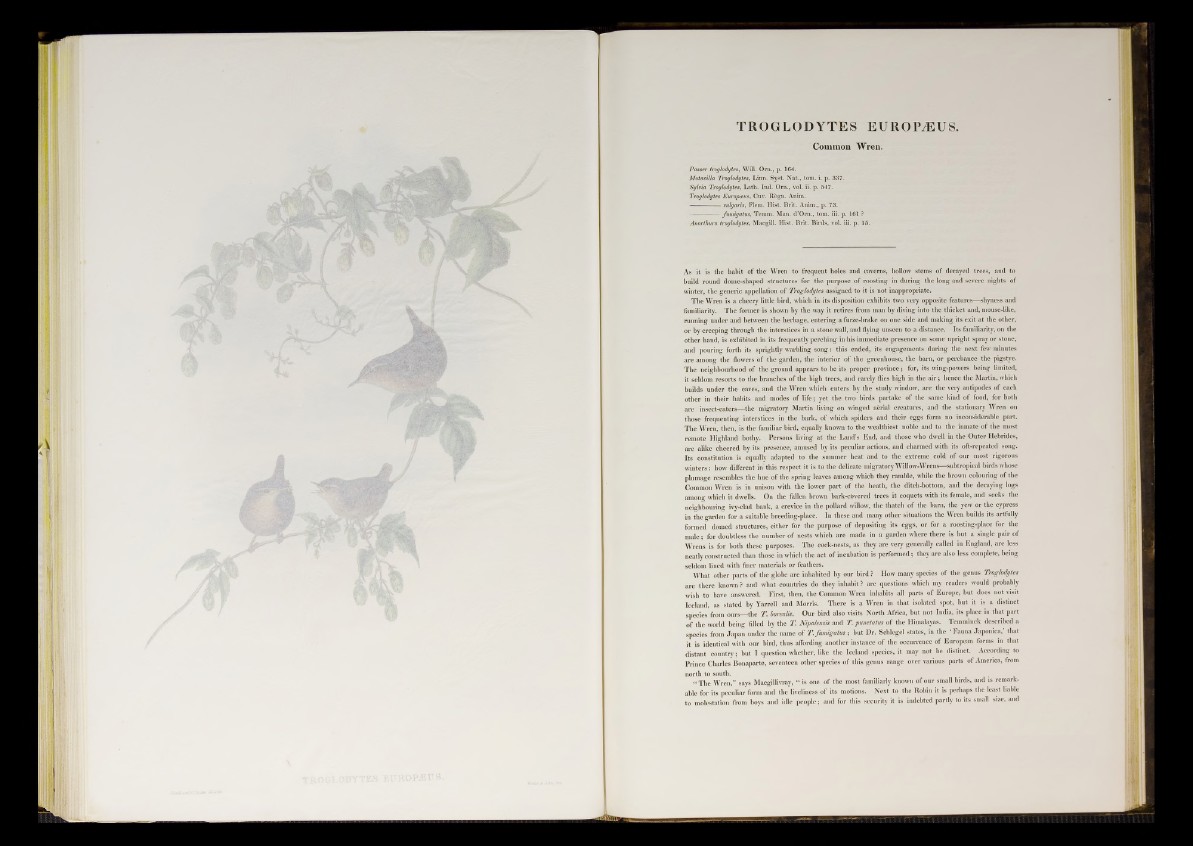
TROGLODYTES EUROPÆUS.
Common Wren.
Passer troglodytes, Will. Om., p. 164.
Motacilla Troglodytes, Linn. Syst. Nat., tom. i. p. 337.
Sylvia Troglodytes, Lath. Ind. Om., vol. ii. p. 547.
Troglodytes Européens, Cuv. Règn. Anim.
-------------- vulgaris, Flem. Hist. Brit. Anim., p. 73.
— fumigatus, Temm. Man. d’Orn., tom. iii. p. 161 ?
Anorthura troglodytes, Macgill. Hist. Brit. Birds, vol. iii. p. 15.
As it is the habit of the Wren to frequent holes and caverns, hollow stems of decayed trees, and to
build round dome-shaped structures for the purpose of roosting in during the long and severe nights of
winter, the generic appellation of Troglodytes assigned to it is not inappropriate.
The Wren is a cheery little bird, which in its disposition exhibits two very opposite features—shyness and
familiarity. The former is shown by the way it retires from man by diving into the thicket and, mouse-like,
running under and between the herbage, entering a furze-brake on one side and making its exit at the other,
or by creeping through the interstices in a stone wall, and flying unseen to a distance. Its familiarity, on the
other hand, is exhibited in its frequently perching in his immediate presence on some upright spray or stone,
and pouring forth its sprightly warbling song: this ended, its engagements during the next few minutes
are among the flowers of the garden, the interior of the greenhouse, the barn, or perchance the pigstye.
The neighbourhood of the ground appears to be its proper province; for, its wing-powers being limited,
it seldom resorts to the branches of the high trees, and rarely flies high in the a ir ; hence the Martin, which
builds under the eaves, and the Wren which enters by the study window, are the very antipodes of each
other in their habits and modes of life; yet the two birds partake of the same kind of food, for both
are insect-eaters—the migratory Martin living on winged aerial creatures, and the stationary Wren on
those frequenting interstices in the bark, of which spiders and their eggs form no inconsiderable part.
The Wren, then, is the familiar bird, equally known to the wealthiest noble and to the inmate of the most
remote Highland bothy. Persons living at the Land’s End, and those who dwell in the Outer Hebrides,
are alike cheered by its presence, amused by its peculiar actions, and charmed with its oft-repeated song.
Its constitution is equally adapted to the summer heat and to the extreme cold of our most rigorous
winters: how different in'this respect it is to the delicate migratory Willow-Wrens—subtropical birds whose
plumage resembles the hue of the spring leaves among which they ramble, while the brown colouring of the
Common Wren is in unison with the lower part of the heath, the ditch-bottom, and the decaying logs
among which it dwells. On the fallen brown bark-covered trees it coquets with its female, and seeks the
neighbouring ivy-clad bank, a crevice in the pollard willow, the thatch of the harn, the yew or the cypress
in the garden for a suitable breeding-place. In these and many other situations the Wren builds its artfully
formed domed structures, either for the purpose of depositing its eggs, or for a roosting-place for the
male; for doubtless the number of nests which are made in a garden where there is but a single pair of
Wrens is for both these purposes. The cock-nests, as they are very generally called in England, are less
neatly constructed than those in which the act of incubation is performed; they are also less complete, being
seldom lined with finer materials or feathers.
What other parts of the globe are inhabited by our bird ? How many species of the genus Troglodytes
are there known ? and what countries do they inhabit ? are questions which my readers would probably
wish to have answered. First, then, the Common Wren inhabits all parts of Europe, but does not visit
Iceland, as stated by Yarrell and Morris. There is a Wren in that isolated spot, but it is a distinct
species from ours—the T. borealis. Our bird also visits North Africa, but not India, its place in that part
of the world being filled by the T. Nipalensis and T. punctatus of the Himalayas. Temminck described a
species from Japan under the name of T. fumigatus; but Dr. Schlegel states, in the ‘ Fauna Japónica,’ that
it is identical with our bird, thus affording another instance of the occurrence of European forms in that
distant country; but I question whether, like the Iceland species, it may not be distinct. According to
Prince Charles Bonaparte, seventeen other species of this genus range over various parts of America, from
north to south.
fa The Wren,” says Macgillivray, “ is one o f the most familiarly known of our small birds, and is remarkable
for its peculiar form and the liveliness of its motions. Next to the Robin it is perhaps the least liable
to molestation from boys and idle people; and for this security it is indebted partly to its small size, and